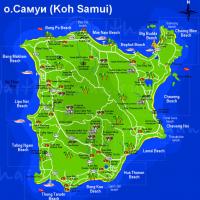Detailed geographic map of Dagestan. A brief history of Dagestan
Dagestan is a republic that is part of the Russian Federation. Satellite map of Dagestan shows that the region borders the Chechen Republic, Stavropol Territory, Georgia, Kalmykia, Azerbaijan and is washed by the Caspian Sea. Territory of the region - 50270 sq. km.
Dagestan is located in the northeastern part of the Caucasus. This is the southernmost subject of the Russian Federation. The region is divided into 42 districts and 10 districts. The largest cities of Dagestan: Makhachkala (capital), Khasavyurt, Derbent, Kaspiysk and Buinaksk. Dagestan's economy is based on agriculture, oil and natural gas production, mechanical engineering, power generation and winemaking.
Khunzakh plateau and Tobot waterfall in Dagestan
A brief history of Dagestan
In 1921, the Dagestan Autonomous Soviet Socialist Republic was formed, which in 1991 was transformed into the Republic of Dagestan.
In 1996, Salman Raduyev's militants took hostages in Kizlyar. From 1996 to 2002, terrorists in Dagestan blew up several residential buildings and a whole military ensemble. In 1999, the Wahhabi mutiny took place, and Chechen separatists invaded Dagestan and were quickly routed.

Naryn-Kala fortress in Dagestan
Sights of Dagestan
On a detailed satellite map of Dagestan, you can see the main natural attractions of the region: the Bazarduzu and Shalbuzdag mountains, the Terek and Sulak rivers, the Khunzakh plateau and the Sary-Kum dune.
It is recommended to visit the largest cities of Dagestan and see their sights: the Naryn-Kala fortress in Derbent, the Cathedral of the Sign in Khasavyurt, the Alburikent mosque, the Anzhi Arena stadium and the Rhodope boulevard in Makhachkala, the Said mosque in Kaspiysk, the mosque in Buinaksk, the fortress-village of Kala -Korein and a mosque in the village of Kumukh.
Tourist notes
Satellite map of Dagestan. Explore the satellite map of Dagestan online in real time. A detailed map of Dagestan was created on the basis of high-resolution satellite images. As close as possible, a satellite map of Dagestan allows you to study in detail the streets, individual houses and attractions of Dagestan. A satellite map of Dagestan easily switches to a regular map mode (diagram).
Dagestan - a republic that occupies the border area of \u200b\u200bthe North Caucasus of Russia. The shores of Dagestan are washed by the waters of the Caspian Sea, and the south of the republic passes into the Dividing Range of the Caucasus. More than 2 million people live on the territory of Dagestan, which makes it the largest republic in the north of the Caucasus.
The diverse relief of the republic makes the weather conditions Dagestan also varied. In general, the climate is distinguished by its dryness and rather high temperatures. Winter in Dagestan is mild, the temperature is + 1 ... + 2. Summer days are dry and hot with an average temperature of +30 C.
Dagestan is one of the richest republics in Russia for sights and historical monuments. On the territory of this region, more than 8 thousand monuments are protected by the state and have federal significance. The most significant sights of the region are the fortress walls of Dagbar, the 11th century Kalakoreish village-fortress, the defensive fortress of Derbent, etc.
The largest number of historical sights can be seen in such ancient cities as Kizlyar and Derbent. The latter is worth visiting not only for the sake of beautiful architecture and historical monuments, but also for the sake of grapes and wine, since Derbent is also a republican center of winemaking and viticulture.
It is impossible not to note the nature of Dagestan and natural attractions. One of them is the Sary-Kum sand dune, 20 km away. from. This is one of the tallest dunes above. Higher dunes can be seen only in the Sahara. In addition, this region is rich in diverse flora and fauna with the rarest plant species.
Another unique natural attraction is the Tobot waterfall, located on the river of the same name. This waterfall is on the list of unique natural monuments of Dagestan.
A small multinational republic of Dagestan, translated from the Turkic "mountainous country", with an area of \u200b\u200babout 50,000 sq. Km. located in the south of Russia. Washed by the waters of the Caspian Sea, surrounded in the south by the foothills of the Greater Caucasus, and in the north by the Caspian lowland, it is part of the Southern Federal District.
Satellite map of Dagestan represents satellite photo of Dagestan in high definition. Use + and - in the left corner of the map to enlarge the satellite image of Dagestan.
Dagestan. Satellite view
Satellite map of Dagestan can be viewed in both a sketch map and satellite view by switching views on the right side of the map.
This Caucasian republic has long been famous for its climatic resources, natural landscapes and special hospitality characteristic of its indigenous people. The capital is the Republic of Makhachkala, the main seaport of Dagestan. Derbent, Kizlyar, Khasavyurt, Buinaksk and Kaspiysk are also large cities.
Makhachkala. Satellite map online
(The map is controlled with the mouse, as well as the signs in the left corner of the map)
The large rivers Sulak, Terek, Samur, Karakoisu and Andean Koisu, Avar Koisu, Kazakumukhsky Koisu form the main river network of Dagestan. Forests occupy 9% of the republic's territory; on the northern slopes of its ridges, mountain meadow-steppes extend, turning into alpine meadows, and tundra and glaciers are characteristic of high-mountain regions. Here is the only liana forest in Russia, the Sulak canyon, Lake Kezenoyam, where trout is abundant, and the Aimakinskoe gorge, with many waterfalls. On the territory of Dagestan, there are several resort areas and a unique reserve where bezoar goat, red deer, jungle cat, Dagestan tur, Caucasian black grouse, pheasants and stone partridges are still found.
About 90% of the local population are Muslims and only the remaining 10% are other confessions. Moreover, in rural areas, the overwhelming majority are Muslims, and in large cities there is a multi-ethnic community. The climate of Dagestan is rather arid, continental, in the mountains, as a rule, the temperature indicators are somewhat lower. There is not much precipitation.
The republic is rich in its cultural and historical heritage; there are many unique attractions here. Two of which, the fortress of Derbent and the citadel of Naryn-Kala, are included in the UNESCO World Heritage List. There are centers of ancient applied arts: chasing, carpet weaving and painted ceramics. Mosques, fortresses, ancient cities and villages are also of interest to tourists.
Hospitable Dagestan is ready to offer its guests a measured rest all year round. These are fascinating excursions, exciting rafting on mountain rivers, and spearfishing and fishing. There is also a unique mountain tourism complex of great interest to climbers from all over the world.
The total length of Dagestan is about 400 kilometers from north to south and 200 kilometers from west to east. At the same time, the terrain is mostly mountainous, from the east the state is washed by the Caspian Sea, and lowland begins in the north. The Republic Square of Dagestan is divided into three districts - Central, South, Gorny and North. The nature is diverse, the climate of the region is warm - there is practically no snow in winter.
Dagestan transport interchanges
Highways of federal significance pass through the Republic, connecting the extreme point of the Russian Federation in the south - the Republic of Azerbaijan with Moscow - the M-29 highway (R-215 since 2018). In addition, the following routes pass through the republic:
- A-167. Kochubey - Mineralnye Vody.
- E-119. It connects Russia, Iran and Azerbaijan.
- R-215. Part of the Asian route AH8 and the Russian federal highway Astrakhan - Makhachkala.
- R-309. Grebenskaya (Chechen Republic) - Khasavyurt.
- R-306. Argun (Chechen Republic) - Buinaksk.
On the satellite map of Dagestan, you can see that all routes pass through its capital, the city of Makhachala. The railway passing through the republic connects the southern borders of Russia with the central and northern ones. In addition, the Gimrinsky tunnel, 4303 meters long, was opened on the territory of the republic.
Dagestan map with cities and villages
The Republic of Dagestan on the map of Russia is the largest region in the North Caucasus. It includes 42 districts, which are divided into villages and village councils, as well as 10 cities, in four of which the total number of people exceeds 100,000.
The capital has a permanent population of about 600,000 people, while Makhachkala is the center of all important roads. You can get to Moscow from Makhachkala by train, covering a distance of 1825 kilometers in one and a half days. On the map of the Republic of Dagestan with the districts, it can be seen that the largest part of the republic's area is occupied by the central region, while the mountainous region is the smallest in terms of area and population.
Satellite map of Dagestan
Satellite map of Dagestan. You can see a satellite map of Dagestan in the following modes: a map of Dagestan with the names of objects, a satellite map of Dagestan, a geographical map of Dagestan.Dagestan - a republic that occupies the border area of \u200b\u200bthe North Caucasus of Russia. The shores of Dagestan are washed by the waters of the Caspian Sea, and the south of the republic passes into the Dividing Range of the Caucasus. More than 2 million people live on the territory of Dagestan, which makes it the largest republic in the north of the Caucasus.
The diverse relief of the republic makes the weather conditions Dagestan also varied. In general, the climate is distinguished by its dryness and rather high temperatures. Winter in Dagestan is mild, the temperature is + 1 ... + 2. Summer days are dry and hot with an average temperature of +30 C.
Dagestan is one of the richest republics in Russia for sights and historical monuments. On the territory of this region, more than 8 thousand monuments are protected by the state and have federal significance. The most significant sights of the region are the fortress walls of Dagbar, the 11th century Kalakoreish village-fortress, the defensive fortress of Derbent, etc. www.site
The largest number of historical sights can be seen in such ancient cities as Kizlyar and Derbent. The latter is worth visiting not only for the sake of beautiful architecture and historical monuments, but also for the sake of grapes and wine, since Derbent is also a republican center of winemaking and viticulture.
It is impossible not to note the nature of Dagestan and natural attractions. One of them is the Sary-Kum sand dune, 20 km away. from Makhachkala. This is one of the tallest dunes above. Higher dunes can be seen only in the Sahara. In addition, this region is rich in diverse flora and fauna with the rarest plant species.



